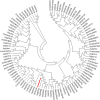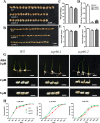Serine carboxypeptidase 46 Regulates Grain Filling and Seed Germination in Rice (Oryza sativa L.)
- PMID: 27448032
- PMCID: PMC4957776
- DOI: 10.1371/journal.pone.0159737
Serine carboxypeptidase 46 Regulates Grain Filling and Seed Germination in Rice (Oryza sativa L.)
Abstract
Serine carboxypeptidase (SCP) is one of the largest groups of enzymes catalyzing proteolysis for functional protein maturation. To date, little is known about the function of SCPs in rice. In this study, we present a comprehensive analysis of the gene structure and expression profile of 59 rice SCPs. SCP46 is dominantly expressed in developing seeds, particularly in embryo, endosperm and aleurone layers, and could be induced by ABA. Functional characterization revealed that knock-down of SCP46 resulted in smaller grain size and enhanced seed germination. Furthermore, scp46 seed germination became less sensitive to the ABA inhibition than the Wild-type did; suggesting SCP46 is involved in ABA signaling. As indicated by RNA-seq and qRT-PCR analysis, numerous grain filling and seed dormancy related genes, such as SP, VP1 and AGPs were down-regulated in scp46. Yeast-two-hybrid assay also showed that SCP46 interacts with another ABA-inducible protein DI19-1. Taken together, we suggested that SCP46 is a master regulator of grain filling and seed germination, possibly via participating in the ABA signaling. The results of this study shed novel light into the roles of SCPs in rice.
Conflict of interest statement
Figures





Similar articles
-
Physiological characteristics and related gene expression of after-ripening on seed dormancy release in rice.Plant Biol (Stuttg). 2015 Nov;17(6):1156-64. doi: 10.1111/plb.12371. Epub 2015 Aug 6. Plant Biol (Stuttg). 2015. PMID: 26205956
-
Cyclin-Dependent Kinase Inhibitors KRP1 and KRP2 Are Involved in Grain Filling and Seed Germination in Rice (Oryza sativa L.).Int J Mol Sci. 2019 Dec 30;21(1):245. doi: 10.3390/ijms21010245. Int J Mol Sci. 2019. PMID: 31905829 Free PMC article.
-
Analysis of the global transcriptome and miRNAome associated with seed dormancy during seed maturation in rice (Oryza sativa L. cv. Nipponbare).BMC Plant Biol. 2024 Mar 26;24(1):215. doi: 10.1186/s12870-024-04928-6. BMC Plant Biol. 2024. PMID: 38532331 Free PMC article.
-
The serine carboxypeptidase like gene family of rice (Oryza sativa L. ssp. japonica).Funct Integr Genomics. 2006 Jan;6(1):14-24. doi: 10.1007/s10142-005-0131-8. Epub 2005 Apr 5. Funct Integr Genomics. 2006. PMID: 15809843 Review.
-
Dormancy and germination: How does the crop seed decide?Plant Biol (Stuttg). 2015 Nov;17(6):1104-12. doi: 10.1111/plb.12356. Epub 2015 Jul 14. Plant Biol (Stuttg). 2015. PMID: 26095078 Review.
Cited by
-
RLB (RICE LATERAL BRANCH) recruits PRC2-mediated H3K27 tri-methylation on OsCKX4 to regulate lateral branching.Plant Physiol. 2022 Jan 20;188(1):460-476. doi: 10.1093/plphys/kiab494. Plant Physiol. 2022. PMID: 34730827 Free PMC article.
-
Genome-wide identification and characterization of lncRNAs in sunflower endosperm.BMC Plant Biol. 2022 Oct 22;22(1):494. doi: 10.1186/s12870-022-03882-5. BMC Plant Biol. 2022. PMID: 36271333 Free PMC article.
-
The Serine Carboxypeptidase-Like Gene SCPL41 Negatively Regulates Membrane Lipid Metabolism in Arabidopsis thaliana.Plants (Basel). 2020 May 29;9(6):696. doi: 10.3390/plants9060696. Plants (Basel). 2020. PMID: 32486049 Free PMC article.
-
Exogenous abscisic acid represses rice flowering via SAPK8-ABF1-Ehd1/Ehd2 pathway.J Adv Res. 2024 May;59:35-47. doi: 10.1016/j.jare.2023.06.012. Epub 2023 Jul 1. J Adv Res. 2024. PMID: 37399924 Free PMC article.
-
Identification and Allele Combination Analysis of Rice Grain Shape-Related Genes by Genome-Wide Association Study.Int J Mol Sci. 2022 Jan 19;23(3):1065. doi: 10.3390/ijms23031065. Int J Mol Sci. 2022. PMID: 35162989 Free PMC article.
References
-
- Hayashi R, Moore S, Stein WH (1974) Serine at the active center of yeast carboxypeptidase. Journal of Biological Chemistry 248: 8366–8369. - PubMed
-
- Feng Y, Yu C (2009) Genome-wide comparative study of rice and Arabidopsis serine carboxypeptidase-like protein families. Journal of Zhejiang University 35: 1–15.
-
- Breddam K (1986) SERINE CARBOXYPEPTIDASES. A REVIEW. Carlsberg Res Commun 51: 83–128.
MeSH terms
Substances
LinkOut - more resources
Full Text Sources
Other Literature Sources
Research Materials

